 Really popular modification that most Jeep owners will do to their Wranglers is to replace the factory front plastic bumper that came with their stock Jeep JK, with a heavy duty offroad bumper. Aftermarket bumpers offer a ton of advantages over the factory bumper, providing better protection for the front of the Jeep, but most of all allowing you to install a winch and additional offroad lighting. Depending on the design, aftermarket offroad front bumper might also increase your Jeep’s approach angle and expose the front wheels, making it easier to put tires on large obstacles. It might also include steel skid plate, protecting the electronic sway bar disconnect motor, if your Jeep has one.
Really popular modification that most Jeep owners will do to their Wranglers is to replace the factory front plastic bumper that came with their stock Jeep JK, with a heavy duty offroad bumper. Aftermarket bumpers offer a ton of advantages over the factory bumper, providing better protection for the front of the Jeep, but most of all allowing you to install a winch and additional offroad lighting. Depending on the design, aftermarket offroad front bumper might also increase your Jeep’s approach angle and expose the front wheels, making it easier to put tires on large obstacles. It might also include steel skid plate, protecting the electronic sway bar disconnect motor, if your Jeep has one.
Aftermarket bumpers generally come in three sizes: full width, mid width, and stubby. When choosing your new offroad bumper you will need to decide on the width, which depends on the way you plan on using your Jeep. You need to also decide if you’re going to mount a winch to it, and whether you prefer a top mounting winch bumper or an in-bumper mounting option with winch plate located between frame rails.
There are plenty of manufacturers offering aftermarket offroad bumpers. You can find different designs made by companies like: Poison Spyder, Rugged Ridge, Rock Hard 4×4, Teraflex, ShrockWorks, Evo Manufacturing, Smittybilt, Artec Industries, M.O.R.E., Crawler Conceptz, LOD, Rampage Products, ARB, Bestop, DV8, Or-Fab, AEV, Rough Country, Warn, Barricade, JCR Offroad, and others. You can often order your new bumper from an online store like Northridge4x4, ExtremeTerrain or Quadratec and if they have it in stock, you’ll receive it in few days. Some manufacturers build your new bumper after you place an order with them, so you will have to be more patient since it might take few weeks before you receive your bumper.
Depending on the brand and design of your new offroad front bumper, there might be some modifications to your Jeep that are necessary before installation. If you go with a bumper that has a winch mounting plate between the frame rails, you need to make sure that it will fit, and that might mean that your vacuum pump needs to be relocated and it’s stock mounting bracket needs to be cut off. Refer to instructions that come with your aftermarket bumper to be clear on requirements.
Obviously before installing your new aftermarket bumper, the factory bumper needs to come off. This is often the part that takes the longest, and if you have factory fog lights, you need to pay close attention to the wires and disconnect everything before pulling off the stock bumper.
Here’s a good video showing you how to remove factory front bumper on your Jeep Wrangler JK.
There were several requirements I had for my new offroad bumper. I decided that I wanted a stubby bumper, with low winch mounting position between frame rails, allowing good air flow to the radiator, integrated recovery points, no fog lights but instead brackets for offroad flood lights, welded-on bull guard providing additional protection, and included skid plate.
After researching for a very long time and reading countless reviews, I decided on a Shrockworks stubby front winch bumper. It checked all the boxes for me, and other owners seem very happy with the quality of their products (especially the quality of their welds).
I contacted the sales person at Shrockworks and discussed all the options. They were very knowledgeable and helpful, and after mentioning that I already own the Superwinch Tiger Shark 9500 winch, I was advised to get the “offset” version of the bumper, with the fairlead slot cut off center, towards driver side. It is due to the position of the drum on the Tiger Shark winch.
This post will describe steps to install a Jeep JK bumper by ShrockWorks, including removal of the vacuum pump bracket to fit the winch plate, as well as installation of the Superwinch Tiger Shark 9500 winch.
Whatever combination of bumper/winch you select for yourself, I would advise you to contact manufacturers of both, to confirm fitment. You can also contact the authorized dealers, including aftermarket offroad parts stores, since they should be knowledgeable in this topic.
(more…)
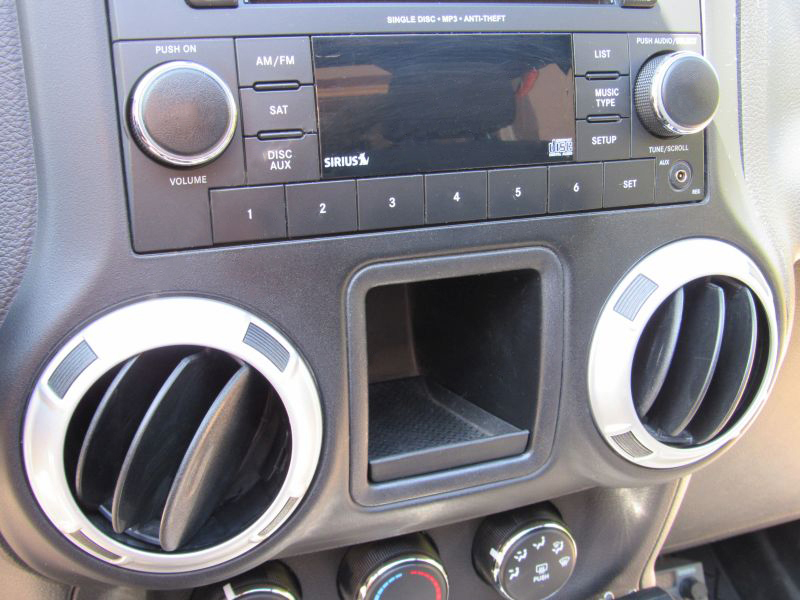 There might come a time when you as a Jeep JK owner find it necessary to remove one or all of the air conditioning outlets located on the dashboard. The most common reason for the A/C vent removal is the desire to paint the stock trim rings in order to color match your Jeep’s exterior and add a fun customization to the interior. You might also need to remove the vent outlet if you accidentally dropped a small item inside the A/C duct and need to retrieve it. After an extremely dry and dusty day wheeling, you might want to do a deep clean of the interior, including cleaning the inside of the air ducts.
There might come a time when you as a Jeep JK owner find it necessary to remove one or all of the air conditioning outlets located on the dashboard. The most common reason for the A/C vent removal is the desire to paint the stock trim rings in order to color match your Jeep’s exterior and add a fun customization to the interior. You might also need to remove the vent outlet if you accidentally dropped a small item inside the A/C duct and need to retrieve it. After an extremely dry and dusty day wheeling, you might want to do a deep clean of the interior, including cleaning the inside of the air ducts.

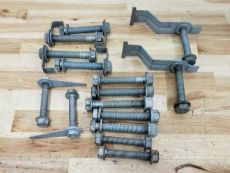 Every Jeep owner who uses their vehicle as intended and goes wheeling, whether it’s simply trail running, overlanding or hardcore rock crawling, should consider having few spare bolts as part of their recovery kit. Your tool bag, recovery gear and spare parts could be the difference between getting stranded in the middle of nowhere, and returning home safely after having a great time on the trail.
Every Jeep owner who uses their vehicle as intended and goes wheeling, whether it’s simply trail running, overlanding or hardcore rock crawling, should consider having few spare bolts as part of their recovery kit. Your tool bag, recovery gear and spare parts could be the difference between getting stranded in the middle of nowhere, and returning home safely after having a great time on the trail. Installing a suspension lift on your Jeep Wrangler is one of the most exciting and most common upgrades any Jeep owner can think of. Lifting your Jeep results in better approach, departure and break over angles, as well as the ability to put on larger tires. When you install larger tires, that’s when you actually increase your vehicles ground clearance. Since the lowest point on your live-axle Jeep is the differential, and it’s part of the axle, only increasing the size of your tires will give you more ground clearance. One aspect of installing a lift and putting on larger tires, which many Jeep owners forget about, is the ability to change your new tires in case you get a flat. Due to your axles being raised, your factory “scissor” jack becomes unsafe to use (remember: since the axle tubes are the proper jack points on your Jeep, it’s the tire size that impacts the location of those points and not the amount of your suspension lift).
Installing a suspension lift on your Jeep Wrangler is one of the most exciting and most common upgrades any Jeep owner can think of. Lifting your Jeep results in better approach, departure and break over angles, as well as the ability to put on larger tires. When you install larger tires, that’s when you actually increase your vehicles ground clearance. Since the lowest point on your live-axle Jeep is the differential, and it’s part of the axle, only increasing the size of your tires will give you more ground clearance. One aspect of installing a lift and putting on larger tires, which many Jeep owners forget about, is the ability to change your new tires in case you get a flat. Due to your axles being raised, your factory “scissor” jack becomes unsafe to use (remember: since the axle tubes are the proper jack points on your Jeep, it’s the tire size that impacts the location of those points and not the amount of your suspension lift). Installing a suspension lift on your Jeep Wrangler is one of the most exciting and most common upgrades any Jeep owner can think of. Lifting your Jeep results in higher ground clearance, better approach, departure and break over angles, as well as the ability to put on larger tires. Upgrading your tire size will require a new tire carrier to accommodate both the heavier weight and larger diameter. Factory tire carrier of a Jeep JK is made of thin aluminum and designed to carry a maximum weight of 50 lbs. under normal to light trail conditions. Exceeding that weight limit could cause damage to the tire carrier or even the tailgate itself. The Wrangler’s tailgate is comprised of an outer and inner shell, spot welded on the inside. When more weight is introduced to the tire carrier, it pulls the carrier back, along with the outer shell. Eventually, the force will begin to pop the welds along the inner shell, separating both pieces and causing damage to the tailgate.
Installing a suspension lift on your Jeep Wrangler is one of the most exciting and most common upgrades any Jeep owner can think of. Lifting your Jeep results in higher ground clearance, better approach, departure and break over angles, as well as the ability to put on larger tires. Upgrading your tire size will require a new tire carrier to accommodate both the heavier weight and larger diameter. Factory tire carrier of a Jeep JK is made of thin aluminum and designed to carry a maximum weight of 50 lbs. under normal to light trail conditions. Exceeding that weight limit could cause damage to the tire carrier or even the tailgate itself. The Wrangler’s tailgate is comprised of an outer and inner shell, spot welded on the inside. When more weight is introduced to the tire carrier, it pulls the carrier back, along with the outer shell. Eventually, the force will begin to pop the welds along the inner shell, separating both pieces and causing damage to the tailgate.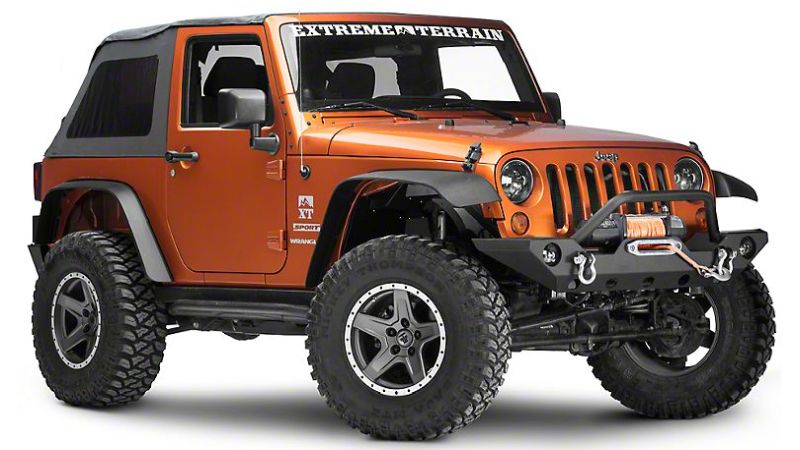
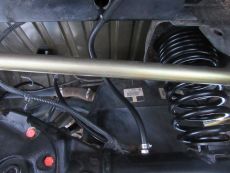 Installing a suspension lift on your Jeep Wrangler is one of the most exciting and most common upgrades any Jeep owner can think of. Lifting your Jeep Wrangler results in higher ground clearance, better approach, departure and break over angles and ability to put on larger tires. That means you can take your Jeep out to the backcountry and enjoy some real offroading. With all that fun, you might eventually find yourself doing a water crossing, or simply playing in mud.
Installing a suspension lift on your Jeep Wrangler is one of the most exciting and most common upgrades any Jeep owner can think of. Lifting your Jeep Wrangler results in higher ground clearance, better approach, departure and break over angles and ability to put on larger tires. That means you can take your Jeep out to the backcountry and enjoy some real offroading. With all that fun, you might eventually find yourself doing a water crossing, or simply playing in mud.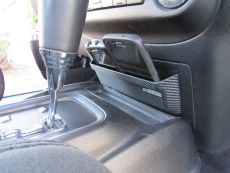 I have never been a big fan of the netting used by Chrysler on the doors and dashboard of the Jeep Wrangler JK, instead of actual pockets. I honestly do not use the door netting at all, since I try do drive doorless as much as possible. I am lucky to live in a warm climate of Arizona, which makes it possible to enjoy doorless driving most of the year.
I have never been a big fan of the netting used by Chrysler on the doors and dashboard of the Jeep Wrangler JK, instead of actual pockets. I honestly do not use the door netting at all, since I try do drive doorless as much as possible. I am lucky to live in a warm climate of Arizona, which makes it possible to enjoy doorless driving most of the year.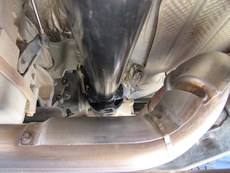 Any Jeep Wrangler owner have experienced weird noises their vehicle makes occasionally. We all realize that Jeeps are not really known for comfort and refinement. They are made for offroading and that’s where they shine, however daily driving, although fun, might make you go insane if you listen to every little unexplained noise your Jeep makes. Some of those noises are due to Wrangler’s shape, resulting in terrible aerodynamics. If you take the top off and install it back without making sure all the seals are perfectly aligned, you will experience loud wind noise. If you upgrade your front bumper or the fenders, you’ll increase drag and the noise will become even louder. Larger, more aggressive tires can be very noisy on asphalt. During daily driving you will most likely hear some squeaking inside the cabin, from the doors or seats for example. There might sometimes be some whining sounds coming from behind the dashboard.
Any Jeep Wrangler owner have experienced weird noises their vehicle makes occasionally. We all realize that Jeeps are not really known for comfort and refinement. They are made for offroading and that’s where they shine, however daily driving, although fun, might make you go insane if you listen to every little unexplained noise your Jeep makes. Some of those noises are due to Wrangler’s shape, resulting in terrible aerodynamics. If you take the top off and install it back without making sure all the seals are perfectly aligned, you will experience loud wind noise. If you upgrade your front bumper or the fenders, you’ll increase drag and the noise will become even louder. Larger, more aggressive tires can be very noisy on asphalt. During daily driving you will most likely hear some squeaking inside the cabin, from the doors or seats for example. There might sometimes be some whining sounds coming from behind the dashboard.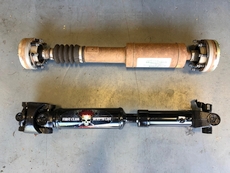 Lifting your Jeep Wrangler JK results not only in higher ground clearance, better approach, departure and break over angles and ability to put on larger tires, but it also causes changes to your driveline as well as steering geometry. Make sure you educate yourself on this topic before installing a lift on your Jeep, especially anything over 3″.
Lifting your Jeep Wrangler JK results not only in higher ground clearance, better approach, departure and break over angles and ability to put on larger tires, but it also causes changes to your driveline as well as steering geometry. Make sure you educate yourself on this topic before installing a lift on your Jeep, especially anything over 3″.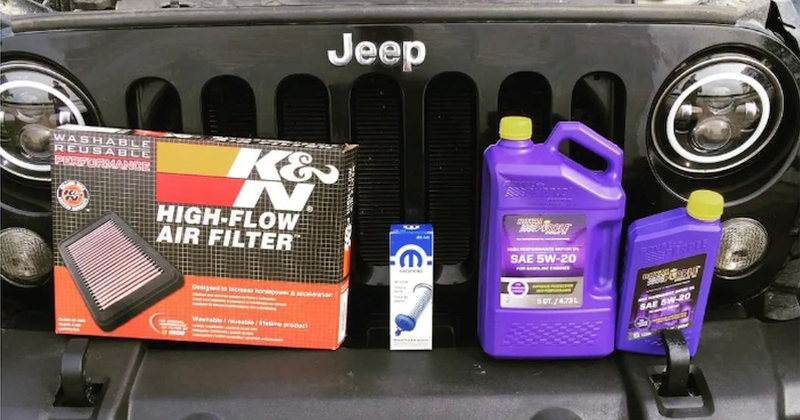
 Really popular modification that most Jeep owners will do to their Wranglers is to replace the factory front plastic bumper that came with their stock Jeep JK, with a heavy duty offroad bumper. Aftermarket bumpers offer a ton of advantages over the factory bumper, providing better protection for the front of the Jeep, but most of all allowing you to install a winch and additional offroad lighting. Depending on the design, aftermarket offroad front bumper might also increase your Jeep’s approach angle and expose the front wheels, making it easier to put tires on large obstacles. It might also include steel skid plate, protecting the electronic sway bar disconnect motor, if your Jeep has one.
Really popular modification that most Jeep owners will do to their Wranglers is to replace the factory front plastic bumper that came with their stock Jeep JK, with a heavy duty offroad bumper. Aftermarket bumpers offer a ton of advantages over the factory bumper, providing better protection for the front of the Jeep, but most of all allowing you to install a winch and additional offroad lighting. Depending on the design, aftermarket offroad front bumper might also increase your Jeep’s approach angle and expose the front wheels, making it easier to put tires on large obstacles. It might also include steel skid plate, protecting the electronic sway bar disconnect motor, if your Jeep has one.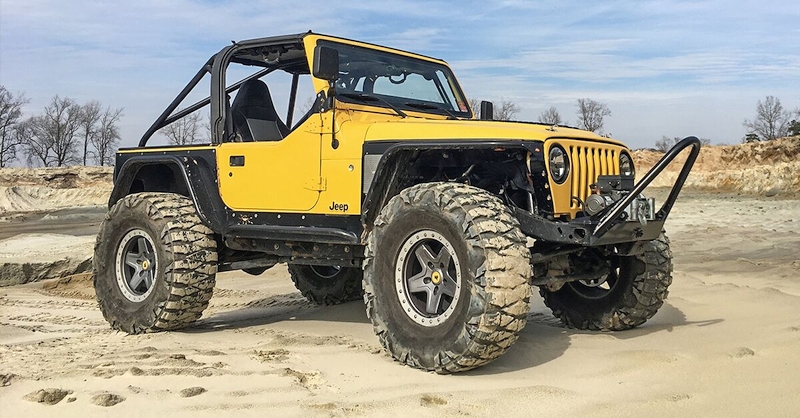
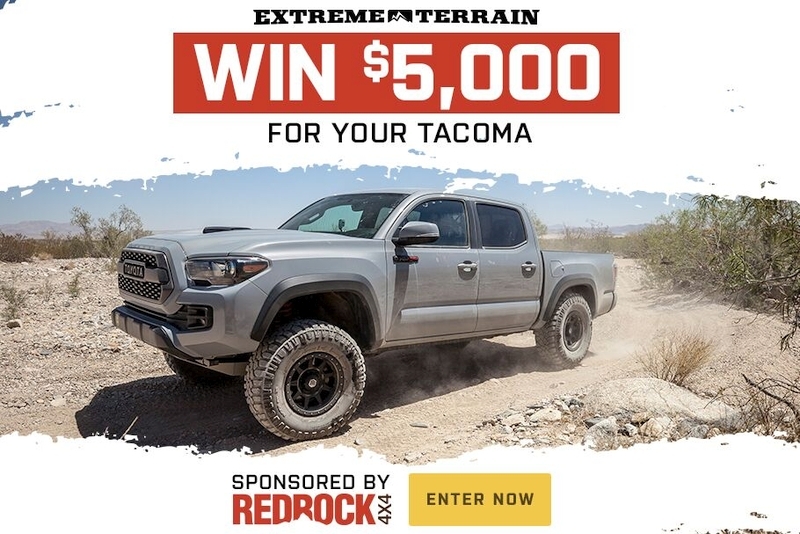
 Jeep Wrangler JK unfortunately lacks proper lighting in the rear cargo area. Any Wrangler owner probably experienced a situation when they were loading or unloading their Jeep after dark and could not see anything in the cargo area behind the back seats.
Jeep Wrangler JK unfortunately lacks proper lighting in the rear cargo area. Any Wrangler owner probably experienced a situation when they were loading or unloading their Jeep after dark and could not see anything in the cargo area behind the back seats.
 Changing the fluid in your Jeep JK front and rear differentials is an important part of routine maintenance. Fresh gear oil insures your differentials are well lubricated and function properly. And, unlike previous Jeep Wranglers, it is not necessary to remove the differential cover in order to do this. It is however recommended that you do so anyway from time to time (possibly every other fluid change) as it will give you a chance to inspect your gears and catch any damage or unusual wear.
Changing the fluid in your Jeep JK front and rear differentials is an important part of routine maintenance. Fresh gear oil insures your differentials are well lubricated and function properly. And, unlike previous Jeep Wranglers, it is not necessary to remove the differential cover in order to do this. It is however recommended that you do so anyway from time to time (possibly every other fluid change) as it will give you a chance to inspect your gears and catch any damage or unusual wear.